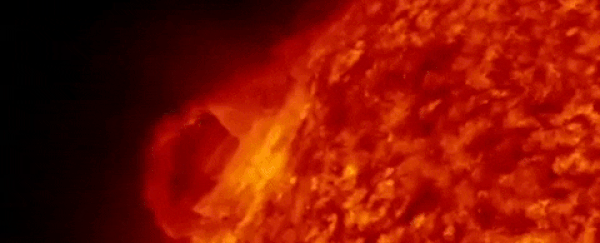The waxing and waning of sunspots forms part of our Sun's natural cycle, but it's a phenomenon astronomers still don't fully understand. Now, new research has revealed that particular "terminator" events are what brings sunspot cycles to an end, and it means we could get better at predicting them.
That would be rather useful, too. If we can predict sunspot cycles on that huge ball of hot plasma with greater accuracy, this will mean more advanced warning of the types of solar storms that can disrupt electronics and infrastructure on Earth.
The findings are based on almost 140 years of solar observations, and include careful recordings of coronal bright points (brief flickers of extreme ultraviolet light) that happen during periods of relative calm on the Sun.
The movement and eventual disappearance of these points is what marks a terminator event, the researchers say.
You can see a visualisation of the tsunami below.
 (©UCAR. Visualization: Mausumi Dikpati, NCAR)
(©UCAR. Visualization: Mausumi Dikpati, NCAR)
"The evidence for terminators has been hidden in the observational record for more than a century, but until now, we didn't know what we were looking for," says astrophysicist Scott McIntosh, from the National Center for Atmospheric Research (NCAR) in the US.
"By combining such a wide variety of observations over so many years, we were able to piece together these events and provide an entirely new look at how the Sun's interior drives the solar cycle."
We already know that a sunspot cycle lasts around 11 years (we're right at the end of one now). After a solar minimum, or a period of quiet on the face of the Sun, the number of sunspots gradually increases again; they form at a latitude of 35 degrees in both hemispheres, before making their way to the equator and eventually dying out.
 Solar minimum (left) and solar maximum (right). (NASA)
Solar minimum (left) and solar maximum (right). (NASA)
This whole process typically takes a little over a decade, with the midpoint known as the solar maximum – when the sunspot activity is most intense. (April 2014 marked the peak of the most recent solar maximum.)
The coronal bright points also travel from higher latitudes towards the equator, though the journey takes longer. At certain points they overlap with sunspots, and the researchers think these bright points are markers of toroidal magnetic field movement. These fields wrap around the Sun like rubber bands, and also migrate towards the equator.
When the magnetic fields rise to the surface of the Sun, sunspots emerge to join the coronal bright points, the scientists propose. As the spots move, they build up plasma behind them. When one wave of a toroidal magnetic field hits another one travelling in the opposite direction on the equator, that plasma is released.
The release is quite dramatic – the research suggests a "solar tsunami" of plasma is let loose, travelling back away from the equator at around 300 metres (or 984 feet) per second. That wave soon meets another toroidal magnetic field coming the other way, causing it to bob up and form sunspots, and the cycle begins again.
This is still a hypothesis for now, but it's based on a lot of accumulated data and some very educated guesswork. With the current solar cycle due to end and start up again within the next year, the scientists will be watching to see if their models and predictions are correct.
As well as promising to teach us more about this fundamental process happening on our host star, the research is a testament to the way multiple observations and multiple data streams can unlock scientific discoveries that would otherwise prove more difficult to uncover.
"We were able to identify these terminators by looking at data from a whole range of different measures of solar activity – magnetic fields, spectral irradiance, radio flux – in addition to the bright points," says astronomer Bob Leamon, from the University of Maryland.
"The results demonstrate that you really need to be able to step back and use all the available data to appreciate how things work – not just one spacecraft or one observation or one model."
The research has been published in Solar Physics and Scientific Reports.
